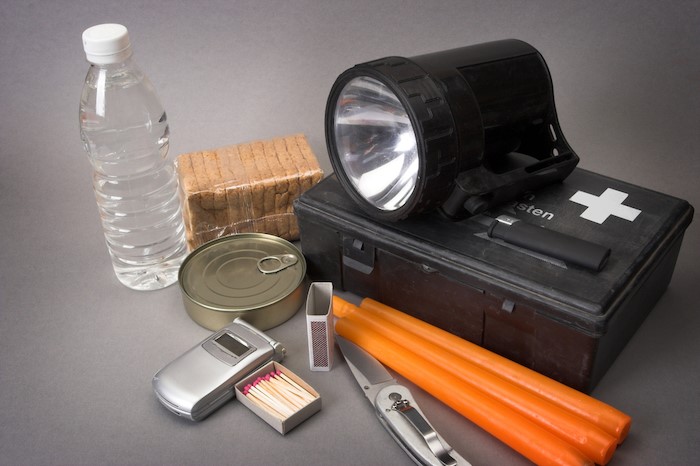A Car Emergency Kit: What You Need for When You Need It Most
If you’re from Virginia, no doubt you remember when motorists were trapped in their cars for 24-hours on 1-95. The interstate had turned into one gigantic ice parking lot!
No one ever expects to be in a situation like that, but that’s the point.
The I-95 event was a very real reminder that every motorist should have a car emergency kit. You just never know when Mother Nature is going to throw you a curve.
But what should a car emergency kit have in it? A lot of that depends on you and your lifestyle. For example, if you have a baby or small children, you want to have emergency provisions for them.
If you live in an extremely cold environment where temperatures routinely dip down below zero, you’ll want to have specific preparations for those conditions.
If you live in a hot, dry area, your emergency supplies would include additional water. The important thing here is to understand that your emergency kit can change somewhat from season to season.
In this post, we go over the foundation of what you need in your kit to prepare for when you need it most.
Putting Your Car Emergency Kit Together
A good car emergency kit should have at least the basics.
First Aid Supplies—You can easily buy a first aid kit. Or you can assemble one yourself. It should include basic antibiotic and pain cremes, tweezers, scissors, pain relievers, hand cleaners, instant cold compress, and, if appropriate, baby supplies.
Element Protectors—Think warm blankets and other clothing that will help to prevent hypothermia.
Items That Signal Rescuers—While traditional flares are still available, LED flares are more reliable, safe, and long-lasting.
A 72-Hour Emergency Kit—Again, you can buy this kit online or make one yourself. Items to include are:
• 1 gallon of water per person per day
• Packaged food (non-perishable)
• Charging devices
• Waterproof matches
• Money/Credit or Debit card
• Flashlight(s) and batteries
• Personal documentation in your phone—Emergency phone numbers, auto insurance provider, and a towing company
Your car emergency kit should also include jumper cables, reflective colored cloth or triangles to make your disabled vehicle more visible.
A fire extinguisher, a snow brush, cat litter (for traction if you’re stuck), and a rain poncho.
Consider What Could Go Wrong
If you’re traveling to a specific destination, it’s a good idea to get the statistics for the area you’re visiting. Are there more prevalent risks for the time of year in which you’re traveling?
What are the general weather patterns? Does the area frequently have tornadoes, ice storms? Check ahead and prepare accordingly.
Check Your Kit from Time to Time
Because medical supplies, food and water supplies can all expire, as well as batteries, it’s important to check the kit from time to time. Replace items as needed.
If You Need to Use Your Car Emergency Kit
First, make sure everyone is safe. Keep yourself and your passengers calm. If you have a phone signal, call for help. Use your flares to indicate a vehicle in distress. Generally, it’s better to stay in your car and wait for help unless your vehicle is unsafe.
At Joe Bowman Auto Plaza, we’re big believers in road safety. Keep your car well-maintained to ensure safer driving on the road. Make emergency preparations just in case, then hope you never have to use them!
When you’re ready to buy a new Chevy or one of our quality preowned cars, turn to our Harrisonburg, VA dealership. We’ve been helping people just like you for 60+ years.
No one ever expects to be in a situation like that, but that’s the point.
The I-95 event was a very real reminder that every motorist should have a car emergency kit. You just never know when Mother Nature is going to throw you a curve.
But what should a car emergency kit have in it? A lot of that depends on you and your lifestyle. For example, if you have a baby or small children, you want to have emergency provisions for them.
If you live in an extremely cold environment where temperatures routinely dip down below zero, you’ll want to have specific preparations for those conditions.
If you live in a hot, dry area, your emergency supplies would include additional water. The important thing here is to understand that your emergency kit can change somewhat from season to season.
In this post, we go over the foundation of what you need in your kit to prepare for when you need it most.
Putting Your Car Emergency Kit Together
A good car emergency kit should have at least the basics.
First Aid Supplies—You can easily buy a first aid kit. Or you can assemble one yourself. It should include basic antibiotic and pain cremes, tweezers, scissors, pain relievers, hand cleaners, instant cold compress, and, if appropriate, baby supplies.
Element Protectors—Think warm blankets and other clothing that will help to prevent hypothermia.
Items That Signal Rescuers—While traditional flares are still available, LED flares are more reliable, safe, and long-lasting.
A 72-Hour Emergency Kit—Again, you can buy this kit online or make one yourself. Items to include are:
• 1 gallon of water per person per day
• Packaged food (non-perishable)
• Charging devices
• Waterproof matches
• Money/Credit or Debit card
• Flashlight(s) and batteries
• Personal documentation in your phone—Emergency phone numbers, auto insurance provider, and a towing company
Your car emergency kit should also include jumper cables, reflective colored cloth or triangles to make your disabled vehicle more visible.
A fire extinguisher, a snow brush, cat litter (for traction if you’re stuck), and a rain poncho.
Consider What Could Go Wrong
If you’re traveling to a specific destination, it’s a good idea to get the statistics for the area you’re visiting. Are there more prevalent risks for the time of year in which you’re traveling?
What are the general weather patterns? Does the area frequently have tornadoes, ice storms? Check ahead and prepare accordingly.
Check Your Kit from Time to Time
Because medical supplies, food and water supplies can all expire, as well as batteries, it’s important to check the kit from time to time. Replace items as needed.
If You Need to Use Your Car Emergency Kit
First, make sure everyone is safe. Keep yourself and your passengers calm. If you have a phone signal, call for help. Use your flares to indicate a vehicle in distress. Generally, it’s better to stay in your car and wait for help unless your vehicle is unsafe.
At Joe Bowman Auto Plaza, we’re big believers in road safety. Keep your car well-maintained to ensure safer driving on the road. Make emergency preparations just in case, then hope you never have to use them!
When you’re ready to buy a new Chevy or one of our quality preowned cars, turn to our Harrisonburg, VA dealership. We’ve been helping people just like you for 60+ years.


